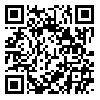Volume 25, Issue 78 (9-2025)
jgs 2025, 25(78): 158-183 |
Back to browse issues page
Download citation:
BibTeX | RIS | EndNote | Medlars | ProCite | Reference Manager | RefWorks
Send citation to:



BibTeX | RIS | EndNote | Medlars | ProCite | Reference Manager | RefWorks
Send citation to:
Rasouli M. (2025). Explanation of different factors of geoculture on Iran-Iraq relations. jgs. 25(78), 158-183. doi:10.61186/jgs.25.78.13
URL: http://jgs.khu.ac.ir/article-1-4269-en.html
URL: http://jgs.khu.ac.ir/article-1-4269-en.html
Tarbiat Modares University, African Studies Center , m.rasouli@modares.ac.ir
Abstract: (5060 Views)
Iraq is regarded as a pivotal element in Iran's foreign policy. For Iranian policymakers, Iraq represents a more critical and, consequently, a more sensitive operational ground than other nations where Iran extends support to local militia groups. Historical evidence indicates that developments in Iraq can have significant repercussions for Iran's stability. Iraq continues to pose a threat to Iran's national security, which underpins Iran's efforts to influence Iraq's internal policies and strategic orientation. Since 2003, Iran has adeptly infiltrated the Iraqi Shia population by capitalizing on the long-standing common borders and cultural, religious, and economic ties with Iraq. Iran's influence is multifaceted, encompassing access to a diverse array of political and social actors. Hence, this research aims to examine the various geocultural factors in Iran-Iraq relations. To accomplish this objective, a descriptive-analytical method and Wizard software were employed. The findings of the research reveal that the divergent factors in geocultural relations between Iran and Iraq are situated in critical and semi-critical conditions. The robust scenario board comprises eight distinct possible situations. Among these eight scenarios, three are classified as critical, one as semi-critical, one as static, two as semi-optimal, and one as optimal. It is also noteworthy that the majority of Iranian and Iraqi citizens share a common religion, namely Shia Islam. The religious seminaries, or hawzas, located in the religious cities of Qom in Iran and Najaf in Iraq serve as centers of Shiite education; however, they have developed within two distinct and competing traditions. This factor presents an opportunity for potential improvement in the situation.
Type of Study: Research |
Subject:
Political geography
References
1. Üye. Duygu Dersan ORHAN (2019). IRANIAN FOREIGN POLICY TOWARDS IRAQ:AN ANALYSIS OF THREE WARS BETWEEN IDEOLOGY AND REALISM, AVRASYA Uluslararası Araştırmalar Dergisi, Araştırma Makalesi
2. W. A. Rivera (2022). The Strategic Culture of Resistance Iranian Strategic Influence in its Near Abroad, Journal of Advanced Military Studies SI, 2022 [DOI:10.21140/mcuj.2022SIstratcul004]
3. Michael Evans (2009). Iranian builders win contracts in city that Shias helps to wreck," The Times (London)
4. Joseph Felter and Brian Fishman, (2008). Iranian Strategy in Iraq - Politics and 'Other Means,'" Occasional Paper Series, Combating Terrorism Center at West Point, October 13, 2008.
5. Gelis-Filho, Antonio (2022). Geoculture: Missing in Action
6. Hofstede, G., Hofstede G.J. & Minkov, M. (2010) Cultures and Organizations,
7. Software of the Mind, Intercultural Cooperation and Its Importance for Survival, New York, McGraw-Hill
8. Solomon, C.M. & Schell, M.S. (2009) Managing across Cultures, The Seven Keys to Doing Business with a Global Mindset, McGraw Hill
9. Kershaw, Milo (2018). How National Identity Influences US Foreign Policy, E-International Relations ISSN 2053-8626
10. Prizel, I. (n.d.). Introduction: statement of arguments. National Identity and Foreign Policy, 1-11. doi:10.1017/cbo9780511582929.002 [DOI:10.1017/CBO9780511582929.002]
11. Mustafayev (2014). The role of religions in conflicts. Available: https://www.geopolitica.info/the-role-of-religionsin-conflicts/
12. Goldis, Vasile (2015). THE POLITICAL CULTURE; POLITICIAL SOCIALIZATION AND ACCULTURATION, DOI: 10.1515/jles-2015-0004 [DOI:10.1515/jles-2015-0004]
13. Swedlow, Brendon (2013). POLITICAL CULTURE, Encyclopedia of Modern Political Thought
14. Castells, Manuel, 2000, The Rise of The Network Society: The Information Age: Economy, Society and Culture, Wiley Blackwell, Volume 1, second edition, 15 august 2000.
15. Fox, J. (2009). Integrating religion into international relations theory. Routledge handbook of religion and politics. 273-92
16. Inboden, W. (2008). Religion and American foreign policy, 1945-1960: the soul of containment. Cambridge University Press [DOI:10.1017/CBO9780511499173]
17. XU, Y. (2012). Religion and international relations in the age of globalization. Journal of Middle Eastern and Islamic Studies (in Asia), 6(4): 19-50. [DOI:10.1080/19370679.2012.12023212]
18. Haynes, J., 2010. "Causes and consequences of transnational religious soft power." In Paper presented at the Political Studies Conference Proceedings.
19. Mandaville, P. and Hamid, S. (2018). Islam as statecraft: How governments use religion in foreign policy. Foreign Policy at Brookings [DOI:10.15868/socialsector.40709]
20. Rogers, B. (2018). Rejecting religious intolerance in South-east Asia. Journal of Southeast Asian Human Rights, 2: 208-35. Available: doi: 10.19184/jseahr.v2i1.7587 [DOI:10.19184/jseahr.v2i1.7587]
21. Kadri, Hichem (2020). Geopolitics of Religion: How Does Religion Influence International Relations and States' Foreign Policies?, International Journal of World Policy and Development Studies ISSN(e): 2415-2331, ISSN(p): 2415-5241 Vol. 6, Issue. 3, pp: 28-37, 2020 URL: https://arpgweb.com/journal/journal/11 DOI: [DOI:10.32861/ijwpds.63.28-37]
22. Bentwich, N. (2015). The religious foundations of internationalism: a study in international relations through the ages. Routledge [DOI:10.4324/9781315671079] [PMID]
23. Haviland, W., Harald, E.L., MacBride, B., & Walrath, D. (2013). Cultural Anthropology: The Human Challenge. Cengage Learning. Retrieved, from http: // gocengage. Com / infotrac
Send email to the article author
| Rights and permissions | |
 |
This work is licensed under a Creative Commons Attribution-NonCommercial 4.0 International License. |

This work is licensed under a Creative Commons — Attribution-NonCommercial 4.0 International (CC BY-NC 4.0)






